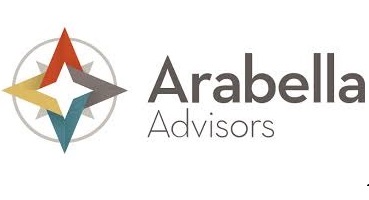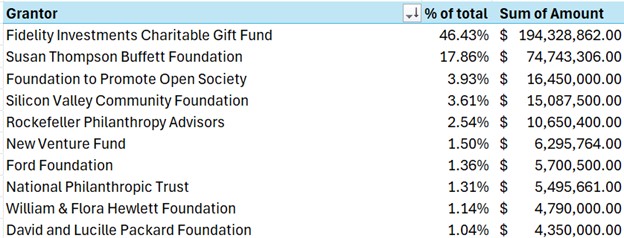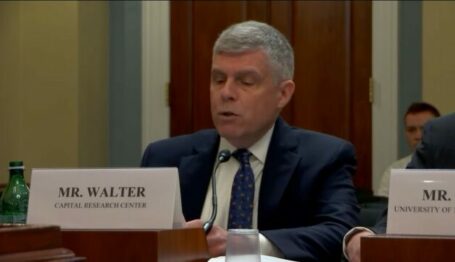Article
Donors to the Arabella Advisors Network


Since 2019 and earlier, the Arabella Advisors network has been the biggest politically charged philanthropic network in America. The Arabella network has been instrumental in almost all the electoral and policy victories the Left has achieved across the nation at the federal, state, and even local levels. That’s why Capital Research Center president Scott Walter wrote a book about them.
From 2019 through 2022, the most recent year for which Form 990 disclosures are available, the four main nonprofit wings of the Arabella network—the New Venture Fund, the Sixteen Thirty Fund, the Windward Fund, and the Hopewell Fund—have taken in roughly $5 billion in total revenues. In an effort to understand who truly funds the world’s largest “dark money” network, Capital Research Center set out to put together a list of all megadonors to the main four Arabella nonprofits.
The compiled data is available in a spreadsheet posted here.
The Data
Using ProPublica’s searchable database of IRS Form 990s, Form 990s published by the organizations themselves, and Form 990s obtained through Capital Research Center records requests, our research compiled a list of the Arabella network’s largest donors from 2018 or 2019 (depending on the organization) through 2022. To limit the data to only the most important donors, researchers used cut-off thresholds for each organization. For the New Venture Fund, the largest of the four, only grantors giving over $1 million were included. For the Sixteen Thirty Fund, the second largest wing, only grantors over $500,000 were included. For the Hopewell Fund and Windward Fund, the threshold was set at $400,000. These thresholds were used for most organizations that sent funds to the Arabella network, but a few exceptions were made for notable donors whose totals were slightly below the threshold.
Grants were identified using the “full-text search” function on ProPublica, searching for the name of each of the four Arabella nonprofits and using the filters to show results from the 990-PF, the form used by 501(c)(3) private foundations, and the Schedule I, the form used by 501(c)(3) public charities and 501(c)(4) social welfare organizations—including donor advised funds (DAFs)—to report grants made during the fiscal year. For the New Venture Fund and the Sixteen Thirty Fund, our most recent data traced funding through 2018 so the filters were set to show forms from 2019 through 2022. Existing data for the Hopewell Fund and Windward Fund, on the other hand, ran only through 2017, so filters for those organizations were set to show forms from 2018 through 2022.
Hurdles to Jump
Many donors—the Ford Foundation for example—listed dozens of different grants to the same Arabella nonprofit each year, with amounts ranging from five-figures to seven-figures. In our dataset, these grants have been totaled up into one yearly amount but the individual grants, often earmarked for a specific fiscally sponsored project, can be found on each grantor’s Form 990 for that year. Our researchers were also careful to avoid double counting grants listed on 990s as “for future payment” since including these grants would have inflated the totals. Another issue with collecting data was that many organizations do not use a traditional January–December fiscal calendar. This made it hard to attribute disclosed grantmaking to one year alone. To at least standardize, if not solve, this problem, grants in the dataset were attributed to whatever year the granting organization’s fiscal calendar ended. This method was chosen because it is the same method ProPublica’s searchable database uses.
What We Found
Among the four main wings of the Arabella network, our researchers were able to record just over $3 billion in funding from large grantors whose funding exceeded the relevant cutoff thresholds. Comparing the sums of our data with the revenues reported by the Arabella nonprofits themselves shows that our research was able to trace more than half of all funding to the Arabella network. All told, our dataset traces 57 percent of New Venture Fund revenues (2019–22), 50 percent of Sixteen Thirty Fund revenues (2019–22), 49 percent of Windward Fund revenues (2018–22), and 69 percent of Hopewell Fund revenues (2018–22).
These numbers tell two stories. First, they show that the Arabella network is mostly funded by millionaire or billionaire donors capable of writing checks for $400,000 or more through a DAF or private foundation. Second, they show that much of the Arabella network’s funding likely comes from large personal donations, completely undisclosed by anybody since they were not routed through another nonprofit. Many of the organizations, activists, and politicians that Arabella has aligned itself with might call this untraceable “dark money.”
Arabella’s Biggest Backers
By totaling up annual contributions, the data also reveals the biggest supporters of the Arbella network since 2018/2019.
For the New Venture Fund, the largest donors were:

The largest donor, Fidelity Investments Charitable Gift Fund, is America’s largest donor-advised fund provider and thus represents the contributions of dozens, hundreds, or even thousands of unknown donors. The funds directed from Fidelity could be coming from anybody. The third largest donor, Silicon Valley Community Foundation, is likewise one of the largest donor-advised fund providers, though much of the funding can be attributed directly to Mark Zuckerberg.
For the Sixteen Thirty Fund, Arabella’s largest 501(c)(4) “dark money” group the largest donors were:

The Arabella network has long shuffled money around among its various nonprofits, making the New Venture Fund itself the largest donor to the Sixteen Thirty Fund. The Hopewell Fund and the North Fund are also Arabella-controlled entities, meaning that the Sixteen Thirty Fund has taken in over $200 million from its sister nonprofits since 2019. Slightly trailing the New Venture Fund is the Berger Action Fund, the personal 501(c)(4) group of Hansjorg Wyss, a Swiss billionaire whose fondness for interfering in U.S. elections is well documented. Wyss’s money accounts for over 30 percent of all funding we were able to trace, and a whopping 16 percent of Sixteen Thirty Fund’s total revenue. Other large donors include the Open Society Policy Center, the leading 501(c)(4) of George Soros’s grantmaking empire; Democracy Fund Voice, controlled by eBay founder Pierre Omidyar; and Chan Zuckerberg Advocacy, belonging to Mark Zuckerberg.
For the Windward Fund, the Arabella wing devoted mostly to environmental activism, the largest donors were:

Finally, for the Hopewell Fund, the Arabella wing most focused on pro-abortion advocacy, the largest donors were:

The Big Three
The cover of Arabella, Capital Research Center’s newly published book, features pictures of “the big three”; billionaire philanthropists Bill Gates, George Soros, and Mark Zuckerberg. Each of them has given a tremendous amount of money to (or through) the main network of Arabella Advisors-managed nonprofits and used it to create policy advocacy projects for their favorite pet sociopolitical issues.
For the “big three” it is important to note that 990s are just one way of documenting grants. An increasing number of major funders, including all of the big three, document their grantmaking in online databases as well. This can be a very useful method of tracking grants that are made through multiple different entities that are linked to one another and for finding grants made more recently than the latest available 990. At the same time, it is important to remember that an organization might track its grants differently in its 990 and its online database, meaning that numbers for any given year will not always align.
Gates
Bill Gates gives through the Bill and Melinda Gates Foundation, a 501(c)(3) private foundation that reported a staggering $63.6 billion total net assets in 2022. According to a database maintained on the foundation’s website, the Gates Foundation has committed a total of $180,360,216 to Arabella-managed nonprofits from 2018 through 2023. The vast majority of this money ($174,360,216) was given to the New Venture Fund. The largest share was from a six-year $70,379,151 commitment made in September 2019 to fund “policy, advocacy, and communications efforts” in the realm of global health and development. Another $25,000,000 multi-year commitment made in November 2020 was for supporting “a leadership journey for mid-career women in global health,” while $15,000,000 was “to provide college scholarships to enable highly motivated, low-income DREAMers to graduate with career-ready degrees.” The Gates Foundation also committed $6,000,000 to the Windward Fund in 2023, most of which was earmarked for methane emissions reduction.
Soros
George Soros gives through a network of grantmaking organizations under an umbrella known as the Open Society Foundations. According to its online database, from 2018 through 2022 this network awarded a total of $153,488,100 to the four main Arabella-managed nonprofits. Of this, $61,935,100 went to the New Venture Fund, while $70,722,000 went to the Sixteen Thirty Fund, $16,831,000 to the Hopewell Fund, and $4,000,000 to the Windward Fund. This money came from two 501(c)(3) private foundations called the Open Society Institute and the Foundation to Promote Open Society, as well as a 501(c)(4) nonprofit called the Open Society Policy Center.
Notably, $17,430,000 of this total was given to support Governing for Impact and the affiliated Governing for Impact Action Fund through the New Venture Fund and the Sixteen Thirty Fund, respectively. Governing for Impact made news in 2022 for its behind-the-scenes work shaping priorities for the Biden Administration through dozens of policy memos.
Zuckerberg
Mark Zuckerberg also gives through a network of grantmakers under the broader Chan Zuckerberg Initiative umbrella. These include the Chan Zuckerberg Initiative, LLC, a 501(c)(3) private foundation called the Chan Zuckerberg Initiative Foundation, a 501(c)(4) nonprofit called Chan Zuckerberg Initiative Advocacy, and the Chan Zuckerberg Initiative Donor-Advised Fund housed at the Silicon Valley Community Foundation, a 501(c)(3). This has major implications for tracking the network’s grantmaking, because all money given through the donor-advised fund would be reported as a grant from the Silicon Valley Community Foundation on the organization’s Form 990. Accordingly, the online database maintained by the Chan Zuckerberg Initiative provides the most complete picture of Zuckerberg’s philanthropy.
According to its online database, the Chan Zuckerberg Initiative has committed a combined $83,284,000 to Arabella Advisors–managed nonprofits from 2018 through 2023. Of this total, 90 percent was given to the New Venture Fund, and over 78 percent of that was earmarked for the Just Trust for Education in 2021, which was at that time a fiscally sponsored project of the New Venture Fund. That same year, the Chan Zuckerberg Initiative committed an additional $109,900,000 to the Just Trust for Action, an independent 501(c)(4) affiliate of the Just Trust that nevertheless pays Arabella Advisors for administrative services. Reports indicate that the Chan Zuckerberg Initiative has committed a total of $350 million to the Just Trust over five years.
The Just Trust is a criminal justice reform advocacy group whose primary goal appears to be reducing punishments for criminal offenses—believing that public safety will be improved at least in part through imprisoning fewer criminals. It has funneled tens of millions of dollars to many dozens of 501(c)(3) and 501(c)(4) grantees, which include various state branches of the American Civil Liberties Unions (ACLU), the American Conservative Union, the Drug Policy Alliance, the Vera Institute of Justice, FWD.us, and the Alliance for Safety and Justice.



